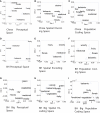Continuous Spatial Representations in the Olfactory Bulb may Reflect Perceptual Categories
- PMID: 22013415
- PMCID: PMC3189554
- DOI: 10.3389/fnsys.2011.00082
Continuous Spatial Representations in the Olfactory Bulb may Reflect Perceptual Categories
Abstract
In sensory processing of odors, the olfactory bulb is an important relay station, where odor representations are noise-filtered, sharpened, and possibly re-organized. An organization by perceptual qualities has been found previously in the piriform cortex, however several recent studies indicate that the olfactory bulb code reflects behaviorally relevant dimensions spatially as well as at the population level. We apply a statistical analysis on 2-deoxyglucose images, taken over the entire bulb of glomerular layer of the rat, in order to see how the recognition of odors in the nose is translated into a map of odor quality in the brain. We first confirm previous studies that the first principal component could be related to pleasantness, however the next higher principal components are not directly clear. We then find mostly continuous spatial representations for perceptual categories. We compare the space spanned by spatial and population codes to human reports of perceptual similarity between odors and our results suggest that perceptual categories could be already embedded in glomerular activations and that spatial representations give a better match than population codes. This suggests that human and rat perceptual dimensions of odorant coding are related and indicates that perceptual qualities could be represented as continuous spatial codes of the olfactory bulb glomerulus population.
Keywords: glomeruli; memory organization; odor quality; olfaction; olfactory bulb; perception; population coding; spatial coding.
Figures



Similar articles
-
Map formation in the olfactory bulb by axon guidance of olfactory neurons.Front Syst Neurosci. 2011 Oct 11;5:84. doi: 10.3389/fnsys.2011.00084. eCollection 2011. Front Syst Neurosci. 2011. PMID: 22013417 Free PMC article.
-
Performance of a Computational Model of the Mammalian Olfactory System.In: Persaud KC, Marco S, Gutiérrez-Gálvez A, editors. Neuromorphic Olfaction. Boca Raton (FL): CRC Press/Taylor & Francis; 2013. Chapter 6. In: Persaud KC, Marco S, Gutiérrez-Gálvez A, editors. Neuromorphic Olfaction. Boca Raton (FL): CRC Press/Taylor & Francis; 2013. Chapter 6. PMID: 26042330 Free Books & Documents. Review.
-
Distributed representation of chemical features and tunotopic organization of glomeruli in the mouse olfactory bulb.Proc Natl Acad Sci U S A. 2012 Apr 3;109(14):5481-6. doi: 10.1073/pnas.1117491109. Epub 2012 Mar 19. Proc Natl Acad Sci U S A. 2012. PMID: 22431605 Free PMC article.
-
A Prism Method for Optical Glomerular Mapping of the Medial Olfactory Bulb in Mice.Front Neural Circuits. 2019 Dec 20;13:79. doi: 10.3389/fncir.2019.00079. eCollection 2019. Front Neural Circuits. 2019. PMID: 31920566 Free PMC article.
-
Functional organization of the main olfactory bulb.Microsc Res Tech. 1993 Feb 1;24(2):142-56. doi: 10.1002/jemt.1070240206. Microsc Res Tech. 1993. PMID: 8457726 Review.
Cited by
-
Odor hedonics coding in the vertebrate olfactory bulb.Cell Tissue Res. 2021 Jan;383(1):485-493. doi: 10.1007/s00441-020-03372-w. Epub 2021 Jan 30. Cell Tissue Res. 2021. PMID: 33515292 Free PMC article. Review.
-
Structural Features of an OR37 Glomerulus: A Comparative Study.Front Neuroanat. 2017 Dec 18;11:125. doi: 10.3389/fnana.2017.00125. eCollection 2017. Front Neuroanat. 2017. PMID: 29326560 Free PMC article.
-
Flexible cognitive resources: competitive content maps for attention and memory.Trends Cogn Sci. 2013 Mar;17(3):134-41. doi: 10.1016/j.tics.2013.01.010. Epub 2013 Feb 18. Trends Cogn Sci. 2013. PMID: 23428935 Free PMC article. Review.
-
What's primary about primary olfactory cortex?Nat Neurosci. 2011 Dec 23;15(1):10-2. doi: 10.1038/nn.3009. Nat Neurosci. 2011. PMID: 22193252 No abstract available.
-
Map formation in the olfactory bulb by axon guidance of olfactory neurons.Front Syst Neurosci. 2011 Oct 11;5:84. doi: 10.3389/fnsys.2011.00084. eCollection 2011. Front Syst Neurosci. 2011. PMID: 22013417 Free PMC article.
References
-
- Alt H., Knauer C., Wenk C. (2003). Comparison of distance measures for planar curves. Algorithmica 38, 45–5810.1007/s00453-003-1042-5 - DOI
-
- Boelens H., Haring H. (1981). Molecular Structure and Olfactive Quality. Technical Report. Bussum: Naarden International

